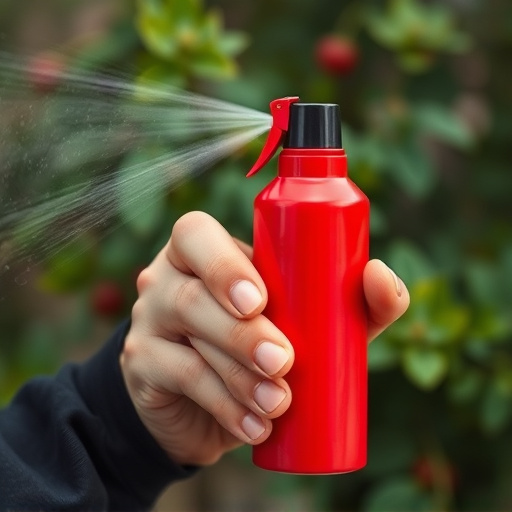Pepper spray training for beginners is vital for responsible riot control. It involves understanding composition, activation, and range, along with de-escalation methods. Beginners should start with low-concentration sprays, upgrading as skills improve. Training focuses on assessment, timing, distance, and target areas, emphasizing safe use as a last resort within legal protocols. Practical exercises mimic real scenarios, preparing officers for high-pressure situations while prioritizing public safety.
In the realm of law enforcement and public safety, understanding pepper spray (also known as inflammatory spray) is paramount, especially for riot control. This comprehensive guide, targeted at beginners, delves into the essentials of pepper spray training. We explore topics like choosing the right spray, safety measures, deployment strategies, and legal considerations. By mastering these fundamentals, officers can effectively manage riot situations while adhering to use-of-force protocols.
- Understanding Pepper Spray: Basics for Beginners
- Choosing the Right Inflammatory Spray for Control
- Safety Measures and Training Techniques
- Effective Deployment Strategies in Riot Situations
- Legal Considerations and Use of Force Protocols
Understanding Pepper Spray: Basics for Beginners
Pepper spray, a powerful tool in riot control and self-defense, has become an essential component of law enforcement and security operations worldwide. For beginners, understanding its mechanics and safe handling is crucial. Pepper spray, also known as oleoresin capsicum (OC) spray, contains capsaicinoids, the same compound that gives chili peppers their heat. When deployed, it creates a temporary but intense irritation in the eyes, nose, and respiratory system, enabling officers to subdue and control agitated or violent individuals.
Proper training is vital for beginners using pepper spray. This includes learning about different types of sprays, their range and duration, and understanding how to activate and aim them effectively. Pepper spray training also covers de-escalation techniques, which are essential in managing volatile situations without resorting to force. Beginners should practice with non-lethal simulations and scenarios to gain confidence in handling this powerful tool responsibly.
Choosing the Right Inflammatory Spray for Control
Choosing the right inflammatory spray for riot control involves understanding your specific needs and environment. Factors like target distance, durability requirements, and ease of use are crucial considerations. For instance, shorter-range sprays might be suitable for close encounters, while longer-range options excel in open areas or situations demanding greater reach. Pepper spray, a popular choice due to its non-lethal nature, offers various strengths and formulations—from basic training aids for beginners to advanced solutions for seasoned professionals.
When opting for pepper spray training for beginners, select products designed for familiarization and safety. These typically feature lower concentrations and controlled release mechanisms to minimize risks while allowing users to learn proper application techniques. As skills improve, upgrading to higher-strength sprays or specialized formulas tailored for specific riot scenarios can significantly enhance control measures.
Safety Measures and Training Techniques
In the realm of riot control, safety measures are paramount. When deploying inflammatory sprays, such as pepper spray, proper training is crucial. Pepper Spray Training for Beginners should focus on understanding the chemical’s effects and safe application techniques to minimize harm to both officers and bystanders. This includes learning how to accurately assess situations, select appropriate targeting areas, and use the spray responsibly, ensuring it’s only deployed when necessary.
Training should also cover de-escalation strategies, as pepper spray is a last resort. Officers must be adept at calming agitated individuals through communication and non-lethal force options before considering spicy aerosol use. Regular practice sessions, simulations, and scenario-based training enable professionals to respond effectively while safeguarding public safety in high-pressure scenarios.
Effective Deployment Strategies in Riot Situations
In riot situations, effective deployment strategies are crucial for law enforcement agencies to maintain control and ensure safety. One key tool in their arsenal is pepper spray, which has proven its effectiveness as a less-lethal option for crowd management. For beginners in pepper spray training, understanding the optimal deployment techniques is essential. Proper timing and distance are paramount; officers should aim for the face, eyes, and nose areas to maximize irritant exposure while minimizing risk to bystanders.
Training programs should emphasize practical exercises that simulate real-world scenarios. Beginners must learn to assess crowd dynamics, identify potential ringleaders, and make split-second decisions on when to deploy the spray. By combining theoretical knowledge with hands-on practice, officers can become proficient in using pepper spray as a crucial tool during riot control operations, ensuring both public safety and officer protection.
Legal Considerations and Use of Force Protocols
The use of inflammatory spray, commonly known as pepper spray, in riot control and crowd management is a complex matter heavily governed by legal considerations and use-of-force protocols. Law enforcement agencies must adhere to strict guidelines ensuring the responsible deployment of such force. Pepper spray training for beginners is essential to understand these protocols, which include assessing the threat level, attempting de-escalation tactics first, and only resorting to pepper spray as a last resort when necessary for self-defense or to prevent serious damage.
Legal frameworks vary across jurisdictions, but many countries have specific regulations dictating when and how pepper spray can be used. These laws often require officers to receive comprehensive training that covers scenarios from simple crowd control to high-risk situations. Regular simulations and real-world applications during training help law enforcement professionals make split-second decisions while adhering to legal boundaries, ensuring the safety of both citizens and officers in volatile environments.
Pepper spray has become a pivotal tool in riot control, offering a non-lethal means to disperse crowds and maintain public safety. As we’ve explored through this guide on pepper spray training for beginners, understanding the basics, choosing the right equipment, and implementing safe deployment strategies are essential components of effective use. Remember, proper training, adherence to legal protocols, and a well-informed approach can ensure that pepper spray acts as a powerful tool for peacekeepers without causing unnecessary harm.
